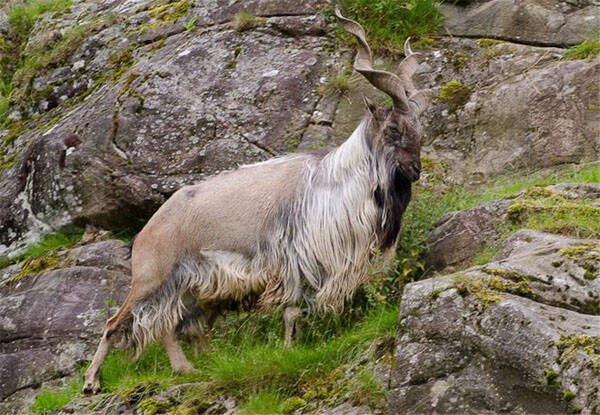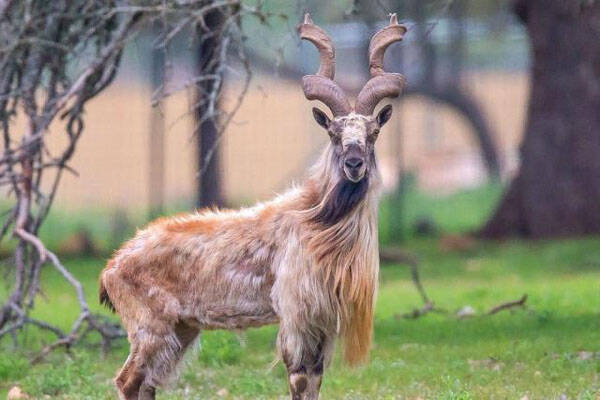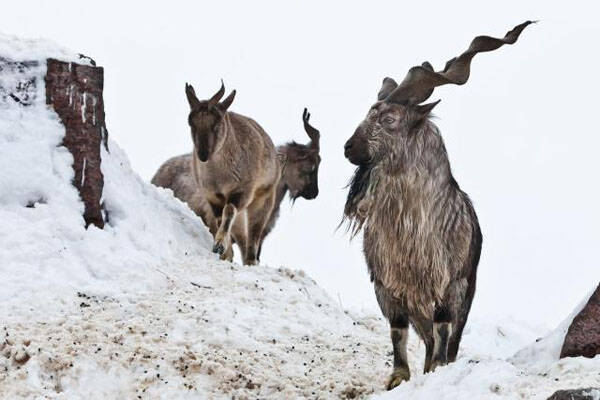Capra falconeri
IUCN
LCBasic Information
Scientific classification
- name:Capra falconeri
- Scientific Name:Capra falconeri,spiral-horned goat
- Outline:Ungulata
- Family:Artiodactyla Bovidae Capra
Vital signs
- length:132-186cm
- Weight:32-110kg
- lifetime:12-13years
Feature
The largest goat
Distribution and Habitat
Markhors have historically ranged from Turkmenistan, Uzbekistan, Tajikistan to Afghanistan, Pakistan and northern India (Kashmir), but their range is now limited. They are found in Nepal, Sikkim, Bhutan, and sometimes cross the border to China, but return shortly after crossing, as this is mainly the territory of other herbivores, and they live only in inaccessible areas at 3,500-5,000 meters above sea level, so even local residents rarely see them.
They generally live in high mountain areas above the tree line, up to 5,000 meters, and prefer rocky environments. They are adapted to mountain terrain with steep cliffs between 600-3,600 meters above sea level. The species usually lives in open woodlands, scrub and light forest areas. In Pakistan and India, these are mainly composed of Quercus ilex, Tibetan white pine, Juniperus chinensis and Cedrus deodora, as well as long-leaf spruce and Tibetan fir. In Tajikistan, the understory consists of open woodlands and shrub communities with P
Appearance
The Markhor is the largest goat, with a body length of 132-186 cm, a shoulder height of 65-115 cm, a tail length of 8-20 cm, and a body weight of 32-110 kg. The female sheep is yellow-brown, with a white belly and black and white stripes on the feet. The ram is light yellow-brown, with the same belly color and stripes on the feet as the female sheep, a black face, and long white hair on the neck and chest that can grow to the knees. Both rams and ewes have screw-shaped horns, which can be up to 160 cm long for rams and 25 cm long for ewes. The weight of the ram's horns is sometimes close to one-third of the weight of the Markhor. The huge and heavy horns cannot be used to deal with carnivorous beasts at all, but are mainly used to attract the opposite sex. Another feature is that the ram's bristles and beards are very long, which is very practical in high-altitude cold areas.
Details
Markhor (scientific name: Capra falconeri) is called Markhor in English, Markhor and Schraubenziege in German, and has three subspecies.

Markhor ewes live in groups of up to 9, while rams generally live alone. During the breeding season, rams fight to attract the attention of ewes. The rams will lock their horns and twist them until they push each other to the ground. The call of the Markhor is like that of a domestic goat.
The huge horns of the Markhor are spiral-shaped. In summer, their hair is short, but in winter, the hair will grow very long, just like wearing a warm fur coat. Due to human hunting and the invasion of diseases, it is now on the verge of extinction.

Markhors mate and reproduce in the fall and winter each year, with one male roosting with multiple females. During the estrus period, males fight each other to compete for mates (a little worrying that the "screws" on their heads are screwed together). The gestation period of females is about 135-170 days, with 1-2 calves per litter, occasionally 3, and the calves are born between April and June of the following year. The lactation period is about 5-6 months. They are sexually mature at 18-30 months old and have a lifespan of 12-13 years, with a maximum lifespan of 19 years.
Most of the latest data on the distribution range of markhors are from different time periods (2008-2014), and the quality is uneven, including information based on observations, estimates, and educated guesses. Most areas have data from 2011-2013, indicating a total of about 8,800 markhors. This figure excludes certain areas where no data was available for that period. Based on earlier data and trends, it is assumed that these areas have a total of about 900 markhors, with a global population of about 9,700. Therefore, the global population is assessed to be more than 5,800 mature individuals.

The number of markhors has declined sharply due to habitat loss caused by overgrazing and continued poaching. One of the habitats, Torghar Hills, was often affected by wars, and local residents hunted them in large numbers, so the species was once on the verge of extinction, with the number of less than 200. In order to protect the markhor, the United States Wildlife Service (USFWS) has intervened in the local conservation plan since 1985. On October 6, 2014, the USFWS released the latest news: the markhor was successfully re-bred, with the number exceeding 3,500, and was officially removed from the endangered list and listed as a vulnerable animal, no longer subject to the US Endangered Species Act.
Since the protection law adopted by the US wildlife organization is to hire 80 forest rangers in the local tribe to patrol and guard to reduce the number of hunting and protect the markhor, now the markhor is no longer protected by the law. In this regard, Jason Goldman, a reporter from Conservation Magazine, expressed his concern: "Rare animals are always particularly attractive." He is worried that once the terms are changed, it will be an opportunity for people to make money, especially poachers who will do anything for money, so he called on the US wildlife organization to continue to protect it.
Protect wild animals and stop eating game.
Maintaining ecological balance is everyone's responsibility!








